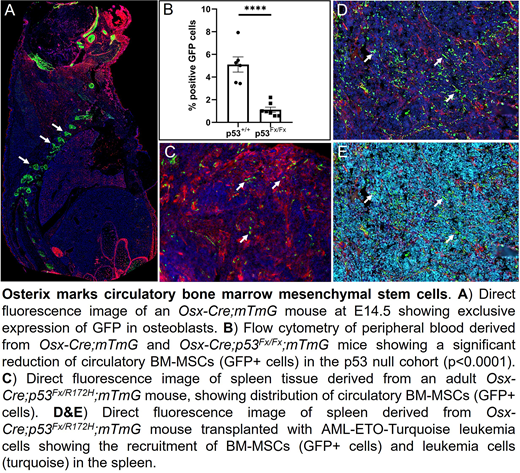Bone marrow mesenchymal stem cells (BM-MSCs) are multipotent stromal cells that can differentiate into a variety of lineages and play a critical role in tissue homeostasis upon injury and repair. Previous studies using Osx-Cre transgenic mice have demonstrated that the expression of Sp7 (Osterix) marks a population of mesenchymal progenitor cells that can differentiate to osteoblasts as well as bone marrow stromal cells (Mizoguchi et al., 2014). Using a lineage-tracing system, we show that in addition to marking mesenchymal progenitor cells in the bone marrow, Osx-Cre also marks a population of BM-MSCs that circulate throughout the body and home in different tissues such as lung, spleen, intestine and muscle. Osx-Cre mice crossed with R26-mTmG reporter mice were analyzed at E14.5 and adulthood by fluorescence microscopy and flow cytometry. At E14.5, GFP+ cells were exclusively located in bone tissues. At two months of age, GFP+ cells were detectable in blood and many other tissues such as lung, liver, spleen and intestine. Flow cytometric profiling indicated that the GFP+ cells were positive for BM-MSC markers CD105, CD73 and CD140a. In order to exclude the possibility of non-specific recombination of the reporter in the non-osteoblast-lineage, as previously reported, we performed a pulse chase experiment utilizing Osx-CreER;mTmG mice. Fluorescence microscopy of the bone marrow upon Tamoxifen injection revealed that Cre activity was primarily limited to the osteoblast-lineage and bone tissue, whereas GFP+ cells were undetectable in lung and spleen, indicating that the GFP+ cells in the lung migrated from the bone marrow. Given that previous reports identified p53 as a negative regulator of osteoblast differentiation (Lengner et al., 2006), we further sought to determine the effect of p53 on circulatory BM-MSCs. Flow cytometric analysis of Osx-Cre;p53Fx/Fx;mTmG peripheral blood cells revealed a significant reduction of circulatory GFP+ cells as compared to p53 wild type mice (p<0.0001) suggesting a role for p53 in expansion of circulatory BM-MSCs. To further characterize the population of circulatory BM-MSCs in a cancer model, we analyzed the population of GFP+ cells in a syngeneic leukemia using fluorescence microscopy and flow cytometry. We transplanted p53 wildtype (Osx-Cre;mTmG) and p53 mutant (Osx-Cre;p53Fx/R172H;mTmG) reporter mice with AML-ETO-Turquoise leukemia cells and the population of GFP+ cells were analyzed three weeks after transplant. The population of GFP+MSCs were significantly increased in bone marrow and spleen, indicating the recruitment of circulatory BM-MSCs. Conclusion: We present the Osx-Cre;mTmG mouse as a faithful model to study circulatory BM-MSCs in vivo and identified a role for p53 in the regulation of circulatory BM-MSCs. We previously reported that BM-derived MSCs home to solid tumors and their metastases and can be successfully used as gene-delivery vehicles, both in murine models and in patients (Studeny et al. JCI 2001, Andreeff et al. AACR 2018). This model is the first to conduct studies of circulating MSCs and to further analyze their role in tumor biology and therapy.
Lengner, C.J., Steinman, H.A., Gagnon, J., Smith, T.W., Henderson, J.E., Kream, B.E., Stein, G.S., Lian, J.B., and Jones, S.N. (2006). Osteoblast differentiation and skeletal development are regulated by Mdm2-p53 signaling. J Cell Biol 172, 909-921.
Mizoguchi, T., Pinho, S., Ahmed, J., Kunisaki, Y., Hanoun, M., Mendelson, A., Ono, N., Kronenberg, H.M., and Frenette, P.S. (2014). Osterix marks distinct waves of primitive and definitive stromal progenitors during bone marrow development. Dev Cell 29, 340-349.
Andreeff:Daiichi-Sankyo; Breast Cancer Research Foundation; CPRIT; NIH/NCI; Amgen; AstraZeneca: Research Funding; Centre for Drug Research & Development; Cancer UK; NCI-CTEP; German Research Council; Leukemia Lymphoma Foundation (LLS); NCI-RDCRN (Rare Disease Clin Network); CLL Founcdation; BioLineRx; SentiBio; Aptose Biosciences, Inc: Membership on an entity's Board of Directors or advisory committees; Daiichi-Sankyo; Jazz Pharmaceuticals; Celgene; Amgen; AstraZeneca; 6 Dimensions Capital: Consultancy; Amgen: Research Funding.
Author notes
Asterisk with author names denotes non-ASH members.


This feature is available to Subscribers Only
Sign In or Create an Account Close Modal